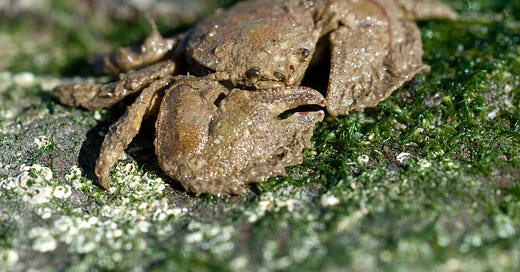Encounter with a Porcelain crab
Imogen introduces us to one of the coastlines most fragile creatures

As the sun cast a weak but welcome light across the beach, I zipped up my jacket against the wind chill and set out for a walk along the shoreline. The beach was deserted, the waves gentle, and the air crisp — a perfect setting for some introspection and nature observation.
As I walked slowly, my gaze was drawn to a myriad of rocks and boulders scattered across the shore. It was under one such rock that I discovered something quite extraordinary — a porcelain crab.

This small, unassuming creature is a marvel to behold. Its body was covered in tiny hairs - velvet-like. Its claws were large, flattened, and distinctly hairy - quite a sight to see, and its muddy browny green colour was perfectly camouflage against the rocky shore shingle. The one I was encountering was a Broad-clawed porcelain crab (Porcellana platycheles) which can be found in numbers, though given its small size and ability to be well camouflaged they are very easy to miss.
These crabs prefer sheltered habitats with moderately strong tidal currents and are adaptable to a variety of swell exposures. They are tiny (15mm) and would fit under a 10p piece (though their relation the long clawed porcelain crab -Pisidia longicornis is even smaller at 5mm!). Porcelain crabs typically live for about 2-3 years.
I remembered reading about these fascinating creatures a year ago. They first appeared in the Tithonian age of the Late Jurassic around 150 million years ago. Living under rocks and boulders on rocky shores, these creatures are actually false crabs - they are non crab crustaceans that have evolved a crab like appearance. They are primarily filter feeders, combing plankton from the water using special hairs on their mouthparts, a skill that seemed almost magical as I watched it in action in the shallow pool of sea water, left behind by the rock I’d lifted as it was nestling into the gravel beneath.
What is truly fascinating about these creature is their mechanism for escaping predators. These delicate crabs lose their appendages to avoid capture or infection — this is a remarkable feature of survival, and probably where they acquire their name “Porcelain Crab”. These legs/claws will eventually re-grow, but it is better not to attempt to touch or pick up these creatures, as it will cause unnecessary harm.
Types of porcelain crab can be found all around the world with the exception of the Arctic and Antarctic. Despite their obvious delicacy, they are really quite adaptable. They can find shelter under rocks, among sponges, or even within the tentacles of giant anemones. Paul Naylor in his book “Great British Marine Animals” notes that colonies of the Long-Clawed Porcelain Crab can live in potato crisp coral (a bryozoan) in deeper waters in the south and west of the UK.
This ability to thrive in various environments is crucial for the survival of these small creatures. They are non-migratory, remaining resident in their selected habitats for life and they reproduce annually. The larvae have a good dispersal potential, extending to around 10km whichs aids in the species' distribution around the UK coastline.
This film by Theo Vickers captured just off the Isle of White shows how they move. Remarkable footage given their unassuming size.
In Scottish waters, these porcelain crabs are primarily seen on rocky or sandy shores - such as the one I was walking along. They are part of the rich marine life that can be observed in Scotland's coastal waters.
As the sun dipped, casting long shadows on the sand, I gently placed the rock back to its original position, ensuring not to disturb the crab’s home and I continued on my walk and reflected on the incredible resilience and adaptability of these small creatures, reminding me of the importance of respecting their habitats, whilst enjoying the natural beauty of the coast.
Imogen Furlong, the High Life Highland Countryside Ranger Manager, is known for her enthusiasm, organisation, and drive. Her deep passion for the Scottish Highlands' wildlife and extensive experience in outdoor education and recreation management have been central to this role. Imogen is a practical and collaborative project manager, empowering her teams to work effectively in communities and contribute to local conservation efforts.






